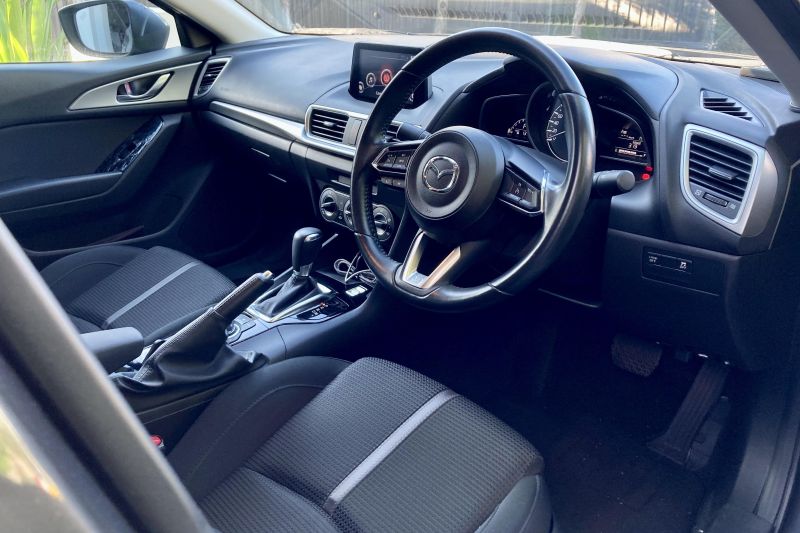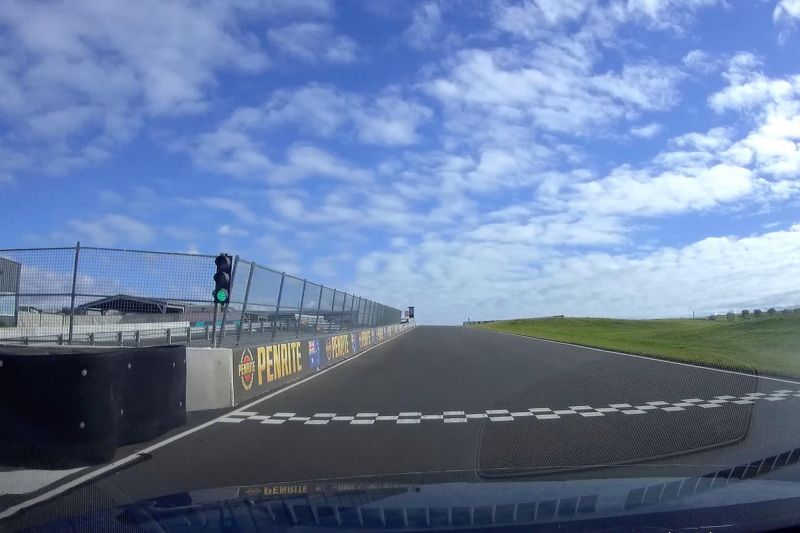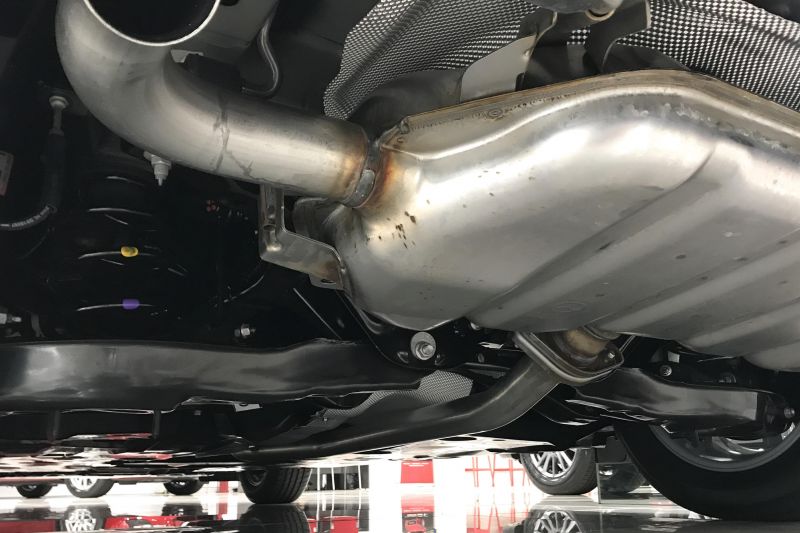About the Mazda 3
Perry purchased this Mazda 3 new with additional options for $23,300 (including all on-road costs). Perry would buy this car again because: “Overall, this Mazda provided an enjoyable ownership experience with many positives. Let’s start with the way it looks.
Remember the mid-1990s Mazda 323 Astina V6 (known elsewhere as the 323F or Lantis)? In my humble opinion, the hardtop Astina remains one of the most handsome sedans to come from the Land of the Rising Sun. Nowadays you’d refer to the slinky shape as a four-door coupe.
I never had the chance to own or drive an Astina hardtop but this elegant third generation 3 seems like a direct descendant. It’s a good example of how sensible transport doesn’t have to look boring too.
We bought the 3 to replace a 2001 Mazda 626, and they are essentially the same size even though the 3 is classed as a small car. Since it’s not actually that small it suited our family of four fine, with adequate space for a rear-facing baby seat behind a passenger seated comfortably in front.
For the driver the cabin was a lovely place to sit, despite being rather monotone in its presentation. After four years the fabric on the seats still looked as good as new, and the interior proved to be hardy with nothing falling off or breaking. Some extra lumbar support on the driver’s seat would have been nice however.
It’s hard to fault Mazda on their ergonomics, with a good driving position and all the major controls being where you expect them to be. The gearshift paddles hidden behind the steering wheel were great for dropping down a few gears for engine braking or better acceleration, and made the Tiptronic-style manual shift redundant.
My favourite feature of the car was the steering – it felt very natural, but still quite direct, which made the 3 feel very agile and fluid, and easy to place through corners.
I thought the balance between ride and handling was also well judged. Pottering around Sydney’s pockmarked roads the 3 was comfortable and unfazed over bumps, more comfortable in fact than our other car (a Mercedes GLC on steel springs and 20-inch wheels). Part of this is due to sensible 16-inch wheels and 50 series tyres, which coincidentally or not are exactly the same 205/50 R16 size as on the aforementioned 323 Astina V6.
The car came with Bridgestone Turanza ER33s, which were grippy enough in the dry on the road and the racetrack.
Whaaat, the racetrack?! I hear you say. Well, the opportunity arose for a private track day at Luddenham Raceway and in the absence of anything better I took the 3.
It was my first track day, and it turned out to be a real eye-opener, so much so that I’d now recommend everyone should experience a track day at least once. You’ll be able to see how your car performs and responds at higher speeds in a safe, controlled environment.
With a 2.0L engine producing 114kW/200Nm, the 3 was certainly no ball of fire on the track but the engine happily revs to the redline, and second and third gears were all that were needed to get around.
How reliable has your car been? Tell us about any issues.
We kept the car for just over four years, and you don’t really expect any mechanical issues in a new car, especially a Japanese-made one with a NA engine and conventional automatic transmission.
The most notable issue we had was some parasitic drain on the battery which was enough to flatten the battery completely when the car was parked for a few weeks.
This happened twice and the battery needed replacing both times. Thankfully the cost of a new Q85 EFB battery has dropped over the years (the second replacement battery cost $165).
The 3 was faultless on the track day; the engine temp (checked through the OBD2 port) remained constant throughout the day. The only preparation done was to clear out junk from the boot and to pump up the tyres.
What do you think of the ownership experience with your car?
Overall it has been an enjoyable experience. As an easy-to-live-with commuter car it met my expectations and I was sad to see it go on the day it was sold.
It looked smart in Machine Grey and after a wash and some silicon on the wheels, it was worth a second glance before walking away.
How has the purchase and aftercare experience been with your car?
We literally walked into our local dealer, agreed on a price without trade-in and bought the car on the spot without a test drive.
Dealer servicing has cost about $400 every year, which is neither cheap nor terribly expensive.
The folding actuators in both mirrors were replaced under warranty – apparently that is quite a common point of failure on recent Mazdas. At the time we bought the 3, it only came with a short three-year warranty.
Are you happy with the price and features of your car?
With the benefit of hindsight, the value offered by small cars before COVID and the Ukraine invasion was quite incredible.
The 3 included all the safety systems and acronyms you’d expect in a modern car, as well as some that you don’t. Our 3 apparently came with ‘G-Vectoring Control’, which (as I understand it) reduces engine torque slightly on turn-in to put extra weight on the front tires, but it’s hard to judge the effectiveness of such things without a back-to-back comparison.
The main omission I wished for is a digital speedo, and auto up/down on all four windows would have been helpful too.
What do you think of the performance and economy of your car?
By today’s standards, the performance offered by the 2.0L SkyActiv-G isn’t anything to write home about, but that’s more a reflection of perceptions than the engine itself. Foot to the floor, an auto 3 should scoot to 100km/h in about 9.3 seconds, which is respectable.
The comparison against the 323 Astina V6 is apt again. The little V6 produced 104kW of power and 183Nm of torque, both less than the 3’s outputs, yet the Astina V6 was considered quite sprightly when it was launched 25+ years ago.
The 2.5L in the SP25 does offer more performance, however the base engine is perfectly fine for city traffic. I didn’t bother with ‘Sport’ mode, as it makes the auto hold the gears too long. Shifts were pretty responsive using the steering paddles.
In respect of fuel consumption, the trip meter often hovered around 10-10.5L/100km, which isn’t particularly economical but not that surprising given that our 3 was mainly used for school runs and other short trips.
The SkyActiv-G is quite a noisy, buzzy unit at start-up, and may be running quite rich until it has warmed up.
What do you think of the technology in your car?
The third generation 3 launched in 2013, the same year as the iPhone 5S, so the 7.0-inch infotainment screen is perhaps looking dated and small in a world where the iPhone 13 Pro Max is nearly as large. It’s still functional and was easy enough to navigate either by touch or though the rotary dial.
The standard GPS sat nav worked reliably however the DAB+ radio dropped out frequently.
I paid ~$500 to retrofit Apple CarPlay, and music and maps apps worked fine aside from the occasional glitch requiring a restart.
When parked in the sun the screen can overheat and shut off until it has cooled off again.
What do you think of the ride comfort and handling of your car?
As mentioned earlier, in my view Mazda nailed the ride/handling balance on the 3. The sharp steering makes the car feel light on its proverbial feet. Yet it also rode bumpy surfaces well and remained stable through corners.
It is interesting to note this generation 3 used a multi-link rear suspension setup, which no doubt contributed to the good ride and handling, however Mazda has since moved to a torsion beam rear end in the latest BP Mazda3.
It is also a shame Mazda didn’t persist with the MPS 3, as this chassis could certainly handle the extra power.





